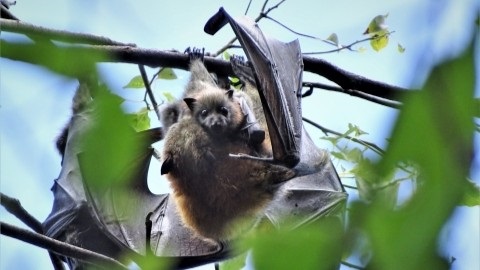Sensors help flying foxes keep their cool
Published 27 October 2025

- City of Moreton Bay has teamed up with tech company Kallipr to roll out 16 sensors to monitor heat stress in flying fox roosts
- The innovative technology provides real time updates on heat and humidity at known roosts
- The data will allow wildlife carers to respond faster to roosts experiencing heat stress
A suite of next-gen sensors designed to monitor temperature and humidity, is helping Council and wildlife carers manage flying fox roosts in Moreton Bay as the city braces for a summer scorcher.
City of Moreton Bay has enlisted the help of Queensland-based tech company Kallipr to roll out 16 specialised sensors across eight different flying fox roost locations, providing real time monitoring data for council officers wary of heat stress events.
The devices also provide alarms when temperatures exceed a pre-determined threshold for flying fox roosts, allowing Council officers to collaborate with wildlife care organisations to take measures to alleviate the impacts of heat stress.
“With South East Queensland experiencing a spring heatwave and summer just around the corner, it’s important we keep tabs on how our native animals are faring,” City of Moreton Bay Mayor Peter Flannery said.
“Using these sensors, Council can not only monitor flying fox roosts for heat stress but pass on this data to researchers to help develop an understanding of heat stress events and what potential mitigation measures can be taken for future events.”
Designed for harsh environments, and able to function in locations that struggle with a reliable cellular network connection, the sensors remove the need for Council officers to physically travel to sites to check on roosts and take temperature measurements.
Moreton Bay is home to three known species of flying foxes - Black and Grey-headed flying foxes are present in the City year round, while Little Red flying foxes are a nomadic summer visitor.
Mayor Flannery said it was important residents did not attempt to handle an injured flying fox and instead contact a local wildlife carer.
“An injured animal is more likely to defend itself if stressed or provoked, so be sure to give them a wide berth and contact a wildlife carer as soon as possible,” he said.
“While less than one per cent of fruit bats (flying foxes) carry Australian Bat Lyssavirus, a bat bite, scratch or exposure to bat saliva through your eyes, nose or mouth can transmit the virus. Always remember -no touch, no risk.”
Deceased animals found on Council-owned roads, parks, and footpaths can be reported to Council for removal by calling 3205 0555 or 1300 477 161.
For more information on flying foxes, visit https://www.moretonbay.qld.gov.au/Services/Environment/Moreton-Bay-Wildlife/Local-Wildlife/Flying-Foxes